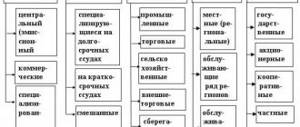Definition
A bank is an institution whose main activity is finance.
The financial institution attracts funds, ensures their storage and carries out settlement transactions. In addition to money, the bank operates with securities and precious metals. Financial institutions operating in the state are managed by the largest bank in the country. In Russia this is the Central Bank of the Russian Federation.
Interesting: The concept comes from the word “banco”, which translated from Italian means bench or table.
In simple words, a bank is an organization whose activity is based on money. It collects them from individuals and legal entities, stores them in storage facilities and lends them at a loan interest rate.
Financial institutions are not allowed to trade, insure or produce.
Classification
What types of financial institutions are there? First of all, we need to highlight two: central and commercial banks.
Central B.
is the only institution of its kind in the country. It regulates and controls the functioning of all financial institutions operating in the state.
Commercial B.
– a banking company operating within the framework of entrepreneurial activities.
Unlike the Central Bank, the main task of a commercial structure is to make a profit. Actually, this is practically the only task of the design bureau. The essence of the work of such entities is expressed in generating income for the founders.
Note 3.
If we talk specifically about the Russian Federation, it is important to understand: the only non-profit bank here is the Central Bank. However, there are many institutions owned entirely or partially by the state.
An example of an organization that can be classified as a state entity is Rosselkhozbank. 100% of the company's shares belong to the state.
People often make mistakes about Sberbank. Most citizens consider it to be a state one. In fact, only 51% of Sberbank shares are state owned.
It is important to say about subspecies
. In Russia there are these:
- Investment.
They are engaged in attracting investment funds, which are then invested in securities. - Savings.
The main purpose of such structures is to store the funds of citizens who entrust their finances to the company. - Specialized.
Such institutions are engaged in one particular area of financial activity. For example, lending. - Universal.
The name speaks for itself - these banks combine all possible directions allowed by law (we wrote about this above).
Note 4.
On the territory of the Russian Federation, most banks are universal.
Essence
The essence of a bank is, first of all, its specificity. Banks have their own means of communication, factories for the production of money, standard means of payment, and act as consultants and intermediaries in negotiations. They perform several hundred services, the number and variety of which continues to increase in the modern economy.
A bank is a specific enterprise that produces its own product, distinguishing it from other enterprises. This is not the activity of a superstructure, but of an element of the basis of society. The bank as an enterprise is a productive institution whose activities are aimed at meeting the needs of market participants.
The productive nature of the bank is visible primarily in the fact that it creates its own specific product. They are: 1. Payment instruments issued at the macro and micro levels. Without money, the products of labor cannot be exchanged, and the reproductive process cannot continue. The issue of cash is a monopoly of the bank; it is produced only by the bank, making it a specific product of the banking system. 2. Accumulated free, temporarily unused resources. By turning “non-working” funds into working ones, banks thereby supply the economy with additional “energy” resources. 3. Loans provided to its clients as capital, as funds returned to their starting point with an increment in the form of newly created value. 4. A variety of services, the productive nature of which is confirmed by the organic inclusion of profit in the total size of the total social product created in the corresponding period of time.
Non-bank credit organizations
The difference between a non-bank credit organization (NPO) and a bank is that the NPO never performs three functions at once, but only certain of them.
Thus, there are two types of NPOs:
- Deposit and credit.
- Calculated.
The main functions of these credit institutions follow from the name of the group. In addition to attracting funds into deposits and providing loans, the first type of NPO has the right to conduct foreign exchange transactions by bank transfer and issue bank guarantees.
The second type of NPO is engaged in maintaining legal accounts. persons, collection, currency exchange transactions in non-cash form and making money transfers without opening an account.
By the way, the abbreviation NPO also stands for “non-profit organization” - legal entity. a person who does not aim to make a profit, therefore, does not have the right to engage in commerce. While a non-bank credit institution always works to generate income.
Kinds
Commercial - the main link of the credit system. They perform almost all types of banking operations. The historical functions of commercial banks are accepting deposits into current accounts, short-term lending to industrial and commercial enterprises, and making payments between them.
Investment - special credit institutions that mobilize long-term loan capital and present it to borrowers (entrepreneurs and the state) through the issuance and placement of bonds and other types of borrowed obligations.
Investment banks are affiliated with investment companies that accumulate the financial resources of private investors by issuing their own securities and placing them in shares and bonds of enterprises both in their own country and abroad.
Savings institutions (savings banks and cash desks) are credit institutions whose main function is to attract savings and temporarily free funds from the population.
Mortgage - credit institutions specializing in issuing long-term loans secured by real estate - land and buildings.
Lending institutions include financial companies, which, unlike firms that provide consumer loans for the purchase of durable goods in installments, do not directly issue credit to consumers, but buy their obligations from businesses, retailers and dealers at a discount.
A venture bank is a bank created to lend to “risky” projects, for example, scientific and technical work with an uncertain or distant effect.
Innovative is a bank that lends to long-term programs related to scientific research and development. The prospects of an innovative project are determined by bank experts.
A special place is occupied by foreign trade or export-import banks , which are designed to provide export lending and insurance of export loans.
A bank holding company is a holding company that owns blocks of shares and other securities of other companies and carries out transactions with these securities.
Large financial transactions - the placement of government loans, the organization of large joint-stock companies - are increasingly carried out not by any individual bank, but through an agreement between several leading banks.
The banking system in market conditions is characterized by banking competition. The issuing and credit functions are separated from each other. The issue of money is concentrated in the central bank, lending to enterprises and the population is carried out by various business banks - commercial, investment, innovation, mortgage, savings, etc. Commercial banks are not responsible for the obligations of the state, just as the state is not responsible for the obligations of commercial banks.
Expenses
All business enterprises have expenses. Banks are no exception to the rule here.
What are the main risks for any financial company? This:
- Attracting a large number of clients - potential investors, as well as minimum volumes of loans issued.
- Non-repayment of the loan provided. Every borrower who fails to meet the terms of the loan is an actual loss. If we add to this the fact that most consumer loans are issued without collateral, the true scale of potential losses becomes clear.
Extraordinary circumstances stand out
. They mean a rapid increase in inflation, default, and a sudden increase in the exchange rate of foreign currencies.
Note 5.
Despite the fact that many banks are provided with state support, during periods of crisis the authorities have to allocate taxpayer funds, since only such a measure in some situations helps the entire banking system to function properly.
Types
The following main types of banks should be distinguished: emission , commercial (specialized, accounting and deposit, savings, mortgage, cooperative, communal). In the vast majority of countries, the issuing bank is the central bank of the country.
In modern banking systems of developed countries, there are two main types of banks:
- commercial;
- central.
The group of commercial banks in different developed countries includes a number of institutions with different structures and different ownership relationships. The very concept of “commercial banks” is not interpreted in the same way in different countries. Their main difference from the central ones is the rights to issue banknotes.
There are two types of commercial banks: universal and special banks:
- Universal ones carry out all or almost all types of banking operations: providing both short-term and long-term loans; operations with securities, accepting deposits of all types, providing all kinds of services, etc.
- Special , on the contrary, specializes in one or a few types of banking operations. In some countries, banking legislation prevents or simply prohibits banks from carrying out a wide range of operations. However, banks' profits from certain special operations can be so large that activities in other areas become unnecessary.
The predominance of one type of bank in the credit system of a country should be understood as a trend. In some countries where, for example, universal banks dominate, there are numerous special banks. Conversely, in countries where specialist banks dominate, especially in recent years, there is an increasing tendency towards universalization. This occurs both as a result of the liberalization of banking legislation in individual countries, and as a result of banks circumventing existing laws. An example is the practice of creating independent special banks that belong to large banks and expand the range of banking operations of the latter.
Countries where the principle of bank specialization prevails include the UK, France, USA, Italy and, with a reservation, Japan. The principle of universalization dominates in Switzerland, Germany and Austria. However, in many developed countries, the statistical differences between these two types of banks are becoming increasingly blurred and controversial, since even in those countries where, according to statistics, special banks dominate, in fact, many of them have already become universal. Any obstacles put up by government authorities on the path to universalization contain loopholes. In the USA, these are bank holding companies . Similar examples exist in other countries. For example, the banking system in Hong Kong has three tiers, which consist of three types of banking institutions, namely licensed banks, restricted licensed banks and deposit withdrawal companies , which are authorized to accept deposits from the public.
The third type of banking institutions for withdrawal of deposits operates with various restrictions. Only licensed banks and banks with a limited license can be called banks.
Rights of credit companies
Each organization involved in the credit and banking sector independently determines the financial services that it will provide to the population and enterprises. For each service, the company receives an appropriate permit.
List of services that a non-banking structure can offer its clients:
- Opening a current, deposit, etc. account.
- Operations for conducting business on customer accounts.
- Carrying out non-cash payments in foreign currency.
- Carry out operations for storing client funds on demand.
- Perform transactions of funds on behalf of clients.
- Perform settlement operations.
- Raise and place funds (with restrictions).
- Carry out leasing operations (long-term rental of production facilities).
- Manage client accounts.
- Conduct collections (with restrictions).
- Carry out the sale and purchase of precious metals. metal (subject to legal restrictions).
- Serve customers in cash register mode.
- Publish with the media the entire list of services provided.
The credit institution is obliged, at the request of the client, to provide him with complete information about all possible services to which it is entitled. Providing permits (copies) is considered mandatory.
The main purpose of banks
The main purpose is to mediate the movement of cash from lenders to borrowers and in payments. As a result, free money turns into a capital percentage of the loan collateral.
Working in the field of exchange, the bank regulates monetary trade in cash and non-cash forms.
Main functions:
- attracting (accumulating) money and converting it into lending capital;
- stimulation of savings in the national economy;
- credit intermediation;
- intermediation in payments;
- creating borrowing funds addresses;
- intermediation in the stock market (in transactions with securities);
- providing consultation, information, etc. services.
Institutions not only create their own resources, they ensure the internal accumulation of funds for the development of the national economy. Incentives to save household funds and capital accumulation are provided by a flexible bank deposit policy in the presence of a favorable macroeconomic situation with the country.
The incentive policy adopts:
- establishment of attractive deposit interest rates;
- high guarantees of the safety of investors' money;
- the bank’s reliability rating and the availability of information about its actions are quite high;
- many deposit services.
Credit intermediation is the most important function of a bank as a credit institution. This ensures the effective redistribution of financial resources in the national economy on the principles of recoverability, urgency and paid nature. Credit operations are the main source of income for the bank.
Payment intermediation is the initial and fundamental function of banks. In a market economy, all accounting enterprises, regardless of ownership patterns, have bank accounts through which all non-cash payments are processed. Banks are responsible for the timely fulfillment of customer orders when making payments.
The creation of a borrowing address represents the production process of the money system of the bank. It is capable of expanding loans and deposits by repeatedly increasing the monetary base. This expansion of the money supply is called the animator effect.
Understanding this process requires an idea of the main types of banking operations. All transactions are divided into passive and active, which is reflected in the bank’s balance sheet.
On responsibility, banks reflect the attractiveness of financial resources - the formation of deposits, and on asset - their placement by issuing loans or investments, for example, in securities.
All funds mobilized by banks in the financial market are represented by its resources, the part of them that can be used to carry out active transactions is called free stock (or credit resource).
Thus, the activities of banks have extremely important social implications. Banks will organize the monetary loan process and issue banknotes.
A certain result of a banking operation is a banking product.
These are special services provided by the bank to customers and cash and non-cash means of payment issued by it. Specific features consist in its intangible content and limitation to the sphere of currency circulation.
Main features of credit institutions
In addition to the basic principles of operation of a legal entity, which is any credit institution, there are some distinctive points in its work that potential borrowers need to know.
- To carry out any banking operations, written permission from the client is required. This may be stipulated in an agreement with a credit institution or a separate document is issued in which the client authorizes the company to carry out specific operations. The lender cannot independently determine what type of services a particular client will need, but is obliged to provide complete information about the service.
- Supervisory organizations (Tax Service, Banking Control Service, etc.) conduct a full audit of the institution’s work and carry out constant monitoring and prescribe an audit procedure for its activities. If the lender violates the client’s rights or does not fulfill obligations properly, the borrower has the right to write a complaint to the regulatory authority or file a claim in court.
- The credit institution is obliged to keep all client transactions secret. All information about the account status, ongoing transactions, etc. is available only to the client after the identification procedure. For this purpose, self-service rooms are being created in the offices of financial and credit companies. Clients have the opportunity to prepare the appropriate documents for access to their account information to their representative (authorized person).
Assets and resources
Banking assets refer to the capital of a financial institution and funds that it has attracted from outside. From an accounting point of view, assets are divided into the following types:
- capitalized – bank property;
- investment – what is invested in subsidiaries of financial institutions, authorized capitals of third-party companies and securities;
- placed - operating and income-generating assets (loans, short-term investments in securities);
- cash - cash collected by cash registers, amounts transferred to Central Bank reserves, correspondent accounts, securities, etc.;
- other types (accounts receivable, etc.).
Functions
- Storing client money: the first historically, and still one of the main functions of the bank.
- Transfer of money from one client to another by bank transfer (by changing the relevant records).
- Loans (loans have a stimulating effect on the production sector of the economy and on entrepreneurship; in addition, another positive aspect of this function is the creation of additional money supply).
- In the resources of banks, attracted and borrowed capital prevails over their own, which entails increased responsibility to client depositors and creditors.
- Simultaneous work with clients from different fields of activity, including with opponents (competitors).
Commercial
One of the important functions of a commercial bank is credit intermediation. Banks carry out the function of intermediation in credit by redistributing funds temporarily released in the process of circulation of enterprise funds and cash income of individuals.
Mediation in payments between individual independent entities. It often refers to the activities of a bank as an intermediary in payments. Payments from enterprises and households pass through banks, and in this sense, banks, being between clients, making payments on their behalf, are, as it were, endowed with an intermediary mission.
Stimulating savings on the farm. The implementation of structural restructuring of the economy should be based on the use mainly and primarily of internal savings of the economy. They, and not foreign investment, should constitute the bulk of the funds needed to reform the economy.
In connection with the formation of the stock market, securities are also included in the orbit of activity. A function such as mediation in transactions with them is being developed. Banks have the right to act as investment institutions that can operate in the securities market as an intermediary; investment consultant; investment company and investment fund. Acting as a financial broker, banks perform intermediary functions in the purchase and sale of securities at the expense and on behalf of the client on the basis of a commission or mandate agreement.
Regulation of money circulation. Banks act as centers through which the payment turnover of various economic entities passes. Thanks to the settlement system, banks create for their clients the opportunity to make exchanges, circulate cash and capital. Regulation of money circulation is also achieved through the issuance of means of payment, lending to the needs of various subjects of production and circulation, mass servicing of the economy and the population. Therefore, we can conclude that this function is implemented through a set of operations recognized as banking and assigned to the bank as a monetary institution.
Consultations and provision of economic and financial information . Banks concentrate information of a general economic and financial nature that is of interest to enterprises. They provide a variety of stock exchange and financial information, often of a confidential nature, primarily to enterprises associated with them by common interests and financial ties.
Most banks offer the following standard set of services:
- For corporate clients: settlement and cash services, lending, including provision of account overdraft, conversion transactions, acting as a currency control agent, documentary transactions, transactions with precious metals, plastic cards (including within the framework of “salary” projects) , placement of funds in deposits, certificates of deposit and bills of exchange, project and trade financing, etc.
- For private clients: car lending, consumer lending, mortgage lending, plastic cards, including credit cards, placing funds on deposit, cash management services, investment and commemorative coins, acting as a currency control agent, money transfers, individual safe deposit boxes, etc. d.
Central
Functions: 1. Monetary regulation of the economy. 2. Issue of credit money - banknotes. 3. Control over the activities of credit institutions. 4. Accumulation and storage of cash reserves of other credit institutions. 5. Lending to commercial banks (refinancing). 6. Credit and settlement services for the government (for example, servicing government bonds, emission and cash execution of the state budget). 7. Storage of official gold and foreign exchange reserves.
Credit regulation. In addition to administrative methods (establishing direct restrictions on the activities of commercial banks, conducting inspections and audits, issuing instructions, collecting and summarizing reports, etc.), central banks also have economic tools for regulating the banking sector. Its main components are: the policy of minimum reserves, open market and accounting policies.
A classic tool in the practice of central banks is the discount rate policy, i.e. setting the interest rate for loans that the central bank provides to commercial banks (refinancing rates). Commercial banks provide the Central Bank with payment obligations - bills of exchange. These can be either banks’ own bills of exchange or obligations of third parties held by banks. The Central Bank buys and discounts these bills, while retaining a certain percentage in its favor. Funds received from the Central Bank are provided to borrowers of commercial banks. The price of this loan - the interest rate - must be higher than the discount rate, otherwise commercial banks will be unprofitable. If the Central Bank increases the discount rate, this leads to an increase in the cost of credit for clients of commercial banks. This helps reduce borrowing and reduce investment. By manipulating the discount rate, the Central Bank has the opportunity to influence capital investment in production.
Income
The main income items of financial institutions are deposits and loans.
Based on this, the main tasks of such institutions are clear: attracting borrowers and investors.
Most banking clients know that the interest rate on deposits is lower than on loans. This leads to an important nuance: the difference between the first and second forms the lender’s profit.
Other articles - secondary - are various kinds of additional services.
Payment transactions and currency exchange involve a certain commission. The bank itself makes a profit from the fact that it sells banknotes at a higher price than it buys. Here we can also mention individual safes (deposit boxes) - a service that is not available in every institution.
Important! A specific income item is penalties and interest for credit delays, which borrowers often commit.
Separately, it is worth mentioning project financing
.
Example 1.
The lender (bank) entered into an agreement with the developer and provided finance for the construction of a residential apartment building, and then provided mortgage loans to future residents to purchase apartments. In view of these facts, it becomes clear that the banking company makes a profit from mortgages and the sale of apartments.
Other possible income-generating services:
- collection;
- information Services;
- consulting;
- third party guarantee;
- acquisition of rights to claim fulfillment of obligations.
This is not a complete list. In fact, there are more sources of profit.
What are banking services?
If we continue to define the concept of a bank, we can come to the conclusion that it is a structure that is engaged in intermediary activities, connecting those who have finance and are ready to invest it, and those who need this finance.
Banking services include the following:
- raising funds by attracting their owners;
- lending;
- cash settlement operations.
The latter means currency conversion, sending transfers, accepting payments.
Each activity has many ramifications. So, if we consider loans, it could be:
- car loan;
- mortgage;
- consumer loan;
- credit payment instrument.
Important: Banks also provide services within the financial sector, issuing loans to each other at interest.
Bank operations
Bank operations are operations to generate bank resources.
- active - using borrowed and own funds to generate income: issuing loans, buying and selling securities, investing.
- passive – raising funds: cash deposits from clients, equity capital, loans from other banks, bonds, etc.
- intermediary - trade commission and commission and settlement operations, trust management of assets, provision of guarantee services, execution of orders, etc.
Money transfers
Operations of this kind are carried out on behalf of individuals and, in most cases, are not accompanied by opening an account. Money transfers can be made to other individuals, as well as to the accounts of organizations (legal entities).
Currency operations
These are actions that involve the acquisition or sale of foreign currency. In some cases, these actions are intermediate (for example, when it is necessary to pay an invoice issued in foreign currency, etc.).
Card service
This category includes all types of banking operations, for which you only need to have the card itself, as well as knowledge of a special code (PIN code). The payment terminal or ATM reads the information embedded in the card (stored on a microchip or magnetic stripe), checks the entered PIN code and then performs the required actions: withdrawing cash, paying for goods or services in a supermarket, transferring funds to another card, etc. d.
Account servicing (ACS)
This category includes any banking operations of banks and other credit institutions carried out in relation to client accounts of all types (for example, transfer of funds from account to account, cash and non-cash payments and settlements, withdrawal or crediting of funds, etc.). This category also includes the execution of payment orders, provision of statements and other documents at the request of clients of a financial institution.
Credit transactions
This category includes all actions carried out during the lending process: granting a loan and credit limit, crediting loan funds to the account, etc. This also includes payments made by the bank client in the process of repaying the loan (including payment of penalties and fines sanctions in case of delay).
Deposit operations
They represent activities to attract funds from clients: placing deposits, servicing accounts, calculating interest, returning funds, etc.
Basic banking operations also include:
- collection
- leasing
- stock exchange operations
- other types of banking activities
Insurance of collateral property
Banks insure collateral, a procedure inseparable from issuing large loans. Insurance is necessary in case of possible damage or destruction of property. The borrower pays for the services; the bank’s task is to offer the most favorable conditions.
Insurance is provided according to several schemes. The options differ in the roles of the bank and the client, who act as beneficiaries and policyholders. The bank may pay the premium, but the cost of insurance will be included in the loan payment.
Role in the economy
All processes associated with the accumulation and movement of money are important for the economic system of the state. However, the bank's functions in the economy are not limited to accumulation and redistribution. In addition to them, such companies also stimulate financial savings in the economic sphere, which directly affects the state of the country's economy. At least, there is a significant component that can be called the security market (stock market), which is also closely related to the banking operation in the intermediation of transactions carried out in shares, bonds and other securities.
Story
Many written sources from ancient times mention usury. Loan interest is often mentioned in the Christian shrine - the Bible. In the Holy Scriptures, this activity is regarded as a matter displeasing to God, undermining the foundations of the state and society.
According to other sources, historians have concluded that already in the 700th century. BC e. In Greek cities there were money changers, accepting deposits and lending money to citizens. The security was a share of the property.
Greek banking practice was extended by the Romans to the western territories - to Britain and Spain. After the collapse of the Roman Empire, the banking system continued to operate. Its rise occurred in the 11th-14th centuries, when the rapid growth of production and trade began.
Until the 17th century, the activities of bankers did not go beyond the boundaries of states. Since, along with honest bankers, there were also deceivers, the population gradually lost confidence in the banking industry. Financial institutions organized at the state level were called upon to correct the situation.
Financial products of the banking sector began to enjoy increased demand in the 19th century, when the industrial revolution occurred. Huge capital was required to invest in the growing industry. Both the population and the state needed money. Thus began the era of banking development. Today, the most important role in their improvement is played by relationships with the state, which regulates the activities of the financial sector and takes measures for its sustainability and development.
Forms of ownership of a credit organization
According to the legislation of the Russian Federation, credit organizations in our country can have two forms of ownership:
Joint Stock Company (JSC)
Since 2015, such companies have been divided into public (PJSC, former OJSC) and non-public (NAO, former CJSC). The difference between them is in the volume of published reporting, in the amount of authorized capital, in the structure of management bodies and in some other nuances. Non-public joint stock companies have the right not to indicate their “non-public” status, so if you see a “JSC” sign on the bank’s doors, this means that the credit institution is non-public. In Russia, PJSC are the largest banks: Sberbank, VTB, PochtaBank and many others. Non-public ones are, for example, Rossiya Bank, OTP Bank, Russian Standard, Tinkoff and others.
Limited Liability Company
Typically, non-bank organizations work with this form of ownership - microloan offices, cash settlement centers, collectors and others. Unlike joint stock companies, these companies are liable for their obligations only to the extent of their authorized capital.
Until 2014, credit organizations could exist in the form of companies with additional liability (organizations in which the founders are responsible to clients with all their property), but in practice this rare type was practically not used in Russia and was eventually abolished.
About bank secrecy
The concept of bank secrecy is not practiced in many countries. So in Russia, although Article 857 of the Civil Code is in force, which states that financial institutions guarantee the protection of information to investors and borrowers, there is a list of organizations that have access to classified information. These are tax, customs authorities, courts, the Accounts Chamber and other organizations. The list continues to expand.
Sources
- https://OPlatezhah.ru/tag/banki
- https://mir-fin.ru/banki.html
- https://www.grandars.ru/student/bankovskoe-delo/bank.html
- https://www.calc.ru/Banki-I-Bankovskaya-Sistema.html
- https://biznes-prost.ru/funkcii-banka.html
- https://obschestvoznanie-ege.ru/%D1%8D%D0%BA%D0%BE%D0%BD%D0%BE%D0%BC%D0%B8%D0%BA%D0%B0-%D1% 82%D0%B5%D0%BE%D1%80%D0%B8%D1%8F/%D0%B5%D0%B3%D1%8D-%D1%8D%D0%BA%D0%BE%D0% BD%D0%BE%D0%BC%D0%B8%D0%BA%D0%B0-%D1%82%D0%B5%D0%BC%D0%B0-19-%D0%B1%D0%B0% D0%BD%D0%BA%D0%B8/
- https://spravochnick.ru/bankovskoe_delo/bankovskie_operacii/
[collapse]











